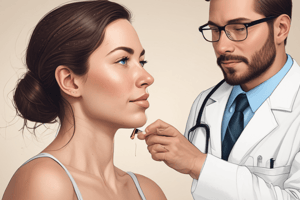Podcast
Questions and Answers
What is the primary function of eccrine glands?
What is the primary function of eccrine glands?
- To regulate blood pressure
- To produce hormones in response to emotional stress
- To aid in the production of hormones related to hair growth
- To help control body temperature (correct)
Where are apocrine glands typically found?
Where are apocrine glands typically found?
- In the axilla and groin regions (correct)
- On the scalp and face
- Behind the ears and under the breasts
- On the palms of the hands and soles of the feet
What is a common symptom that may indicate a skin-related issue?
What is a common symptom that may indicate a skin-related issue?
- Rash or pruritus (correct)
- Fatigue
- Nausea
- Headache
When conducting a skin examination, what is the recommended lighting condition?
When conducting a skin examination, what is the recommended lighting condition?
What is an important consideration when examining the skin?
What is an important consideration when examining the skin?
What is a recommended technique for examining the skin?
What is a recommended technique for examining the skin?
Why is it important to ensure the patient is comfortable during the skin examination?
Why is it important to ensure the patient is comfortable during the skin examination?
What is an important area to inspect during the skin examination?
What is an important area to inspect during the skin examination?
What is a characteristic of a macule?
What is a characteristic of a macule?
What is a papule?
What is a papule?
Why are bedbound patients particularly susceptible to skin damage and ulceration?
Why are bedbound patients particularly susceptible to skin damage and ulceration?
What is the ideal way to inspect the skin that overlies the sacrum, buttocks, greater trochanters, knees, and heels?
What is the ideal way to inspect the skin that overlies the sacrum, buttocks, greater trochanters, knees, and heels?
What is the purpose of recording the physical examination?
What is the purpose of recording the physical examination?
What is a characteristic of a vesicle?
What is a characteristic of a vesicle?
What is the primary function of the skin in terms of body fluid regulation?
What is the primary function of the skin in terms of body fluid regulation?
What percentage of body weight does the skin account for?
What percentage of body weight does the skin account for?
Which of the following is NOT a function of the skin?
Which of the following is NOT a function of the skin?
What is the main difference between vellous hair and terminal hair?
What is the main difference between vellous hair and terminal hair?
What is the primary function of sebaceous glands?
What is the primary function of sebaceous glands?
Which of the following is NOT a layer of the skin?
Which of the following is NOT a layer of the skin?
What is the function of nails in the human body?
What is the function of nails in the human body?
What is the area of the skin in square meters?
What is the area of the skin in square meters?
What is the primary reason for asking permission to expose the area to be examined?
What is the primary reason for asking permission to expose the area to be examined?
What is the purpose of inspecting the skin for lesions?
What is the purpose of inspecting the skin for lesions?
What is the correct way to palpate for temperature?
What is the correct way to palpate for temperature?
What is the significance of inspecting the hair and scalp?
What is the significance of inspecting the hair and scalp?
Why is it essential to wash your hands during an examination?
Why is it essential to wash your hands during an examination?
What is the purpose of inspecting the anterior and posterior aspect of the body surface?
What is the purpose of inspecting the anterior and posterior aspect of the body surface?
What is the correct technique for palpating lesions?
What is the correct technique for palpating lesions?
Why is it important to inspect the axillae and inguinal areas?
Why is it important to inspect the axillae and inguinal areas?
What is the primary purpose of assessing skin turgor?
What is the primary purpose of assessing skin turgor?
What is the characteristic of a primary lesion?
What is the characteristic of a primary lesion?
What is the best way to assess oxyhemoglobin?
What is the best way to assess oxyhemoglobin?
What is the purpose of the ABCDE rule in assessing skin lesions?
What is the purpose of the ABCDE rule in assessing skin lesions?
What is the significance of palpating the skin of the face, neck, trunk, arms, and legs?
What is the significance of palpating the skin of the face, neck, trunk, arms, and legs?
What is the purpose of using the dorsum of the hands to assess skin temperature?
What is the purpose of using the dorsum of the hands to assess skin temperature?
What is the significance of assessing the quantity, distribution, and texture of lesions?
What is the significance of assessing the quantity, distribution, and texture of lesions?
Why is it important to consider the patient's history and physical examination when assessing skin lesions?
Why is it important to consider the patient's history and physical examination when assessing skin lesions?
Flashcards are hidden until you start studying
Study Notes
Anatomy and Physiology of Skin
- Skin functions: regulates body temperature, protects underlying tissues, aids in excretion, synthesizes vitamin D, and provides sensation
- Skin layers: epidermis, dermis, superficial fascia, and deep fascia
- Skin appendages: hair, nails, sebaceous glands, and sweat glands
- Hair types: vellous (fine, unpigmented) and terminal (coarser, pigmented)
- Nail function: protects distal ends of fingers and toes
- Sebaceous glands: produce fatty substances, found everywhere except palms and soles
- Sweat glands: eccrine glands (widely distributed, helps control body temperature) and apocrine glands (found in axilla and groin, stimulated by emotional stress)
Health History
- Common skin symptoms: hair loss, nail changes, rash, pruritus, moles, and growths
- Questions to ask patients:
- Have you noticed any changes in your skin, hair, or nails?
- Have you had any rashes, sores, or lumps?
- Have you had any new moles?
Techniques of Examination
- Inspect the skin in a systematic order, including:
- Anterior and posterior surfaces of the body
- Behind the ears, axillary, under the breasts, inguinal regions, genitalia, and intergluteal crease
- Palms and soles, web spaces (interdigital areas)
- Hair distribution and condition
- Nails
- Use a dermoscope in good light, preferably natural light
- Palpate the skin, noting characteristics such as:
- Color
- Moisture
- Temperature
- Texture
- Mobility and turgor
- Lesions
Tips for Skin Examination
- Conduct the examination in a private space with the patient's permission
- Ensure the patient is comfortable and ask if they would like a chaperone present
- Inspect and palpate the skin, using the palm of the hand and fingers
- Wash hands before and after the examination
Inspection
- Inspect skin for:
- Rashes
- Lesions
- Bruises
- Nevi
- Color changes
- Scars
- Inspect specific areas, including:
- Upper and lower back
- Shoulders, arms, and hands
- Chest and abdomen
- Anterior and posterior thighs and legs
- Feet and toes
- Axillae and inguinal areas
- Scalp, face, and neck
Palpation
- Palpate the skin, noting:
- Tenderness
- Lesions
- Temperature
- Texture
- Mobility and turgor
- Palpate the scalp, hair, and nails
Lesions
- Primary lesions: develop as a direct result of the disease process
- Secondary lesions: result from changes in primary lesions
- Characteristics of lesions: number, size, color, texture, shape, location, and configuration
- DANGER SIGNS: ABCDE (Asymmetry, Border irregularity, Color variation, Diameter, Elevation and Enlargement)
Evaluating the Bedbound Patient
- Bedbound patients are susceptible to skin damage and ulceration due to pressure sores
- Inspect the skin that overlies the sacrum, buttocks, greater trochanters, knees, and heels
Recording the Physical Examination
- Use sentences or phrases to describe findings, such as color, skin temperature, and nail condition
Studying That Suits You
Use AI to generate personalized quizzes and flashcards to suit your learning preferences.




